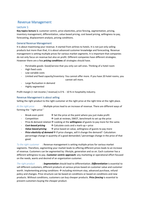Revenue Management
Lecture 1:
Key topics lecture 1: customer centric, price elasticities, price fencing, segmentation, pricing,
inventory management, differentiation, value based pricing, cost based pricing, willingness to pay,
forecasting, displacement analysis, pricing conditions.
General Revenue Management
It is about maximizing your revenue. It started from airlines to hotels. It is not just only selling
products but more than that, it is about advanced customer knowledge and forecasting. Revenue
management is setting multiple prices for various market segments. It is important that companies
do not only focus on revenue but also on profit. Different companies have different strategies.
However there are a few pricing conditions all strategies should have.
- Perishable goods: Good/service that you only can sell ones. Thinking of a hotel room
- High fixed costs
- Low variable costs
- Limited and fixed capacity/inventory: You cannot offer more. If you have 20 hotel rooms, you
cannot sell more.
- Large fluctuation in demand
- Highly segmented
Profit margin (= net income / revenue) is 0 % – 10 % in hospitality industry.
Revenue Management is about selling
Selling the right product to the right customer at the right price at the right time at the right place.
At the right price : Multiple prices lead to an increase of revenue. There are different ways of
forming the ‘’right price’’
- Break-even point Set the price at the point where you just make profit
- Competition Look at reviews, SWOT, benchmark to set up the price
- Price & demand relation Looking at the willingness of guests to pay more for the same.
- Cost-based pricing Calculate costs and x mark-up = price
- Value based pricing price based on value, willingness of guests to pay more
- Price elasticity of demand If price changes, will it change the demand? Calculation:
percentage change in quantity of a good demanded / percentage change in the price of that
good.
To the right customer : Revenue management is setting multiple prices for various market
segments. Therefore, segmenting your market leads to offering different prices leads to an increase
of revenue. Customers can be segmented by: lifestyle, generation and so on. Each customer has a
different willingness to pay. Customer centric approach: any marketing or operational effort focused
on the needs, wants and desired of an organization customer.
The right product : Segmentation should lead to differentiation. Differentiation is essential to
sell different customers, different products at various prices based on customer value and customer
worth. Implementing pricing conditions including minimum stay, advanced purchase, refund
policy and changes. Price structure can be based on conditions or based on conditions and new
products. Without conditions, customers can buy cheaper products. Price fencing is essential to
prevent customers buying the cheaper product.





